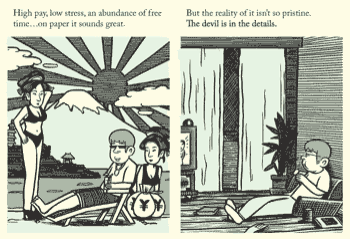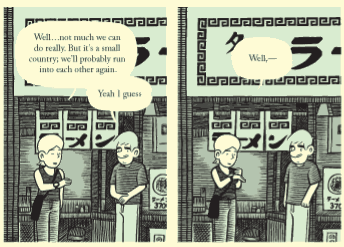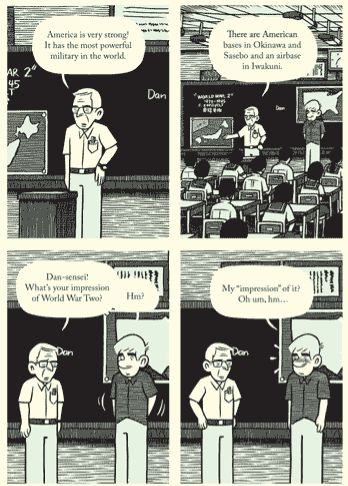Back
Tōnoharu Part 1 (of 4)

A new series of hardcover books by Lars Martinson, published by his Pliant Press; this first volume is $19.95 for 128 two-color pages, and was funded in part by a September 2007 Xeric Grant.
I'm pretty glad this book is out there, being a Japan-set comic by a young Westerner that has absolutely no interest pop cultural matters, or Japanese comics or cartoons, or teeming urban sprawl or historical intrigue - the closest this thing gets to manga is its evocation of Hokusai on the front cover. Martinson spent three years in Japan as an assistant English teacher through the government-backed Japanese Exchange and Teaching (JET) Program, and is currently working through a Monbusho Research Scholarship to study calligraphy and ink drawing; his view of the place, as glimpsed in this book, is heavy with concern for the many cultural mores and customs an outsider must grasp in order to work from the inside, to say nothing of the isolation of language.

And it's this focus that goes a ways toward energizing Martinson's story, which is essentially another book about an awkward, sensitive young man who has no luck with girls, marching uncertainly through his life. Following a narrated Prologue in which a Martinson stand-in (or so it seems) acclimates us to the setting and introduces us to various characters, the book jumps backwards a year on its timeline for the 'main' story, focusing on one Daniel Wells' abridged time teaching English and living in the rural village of the title. As such, we know he'll only last one out of a possible three years, and it's clear that something happened among the supporting characters during his time, and I guess that's the suspense.
This isn't a suspense comic, though; it's sort of a heavily formal memory, broken up into exact bits of anecdote and presented to the reader in chronological order. This feeling is bolstered by Martinson's design approach, adopting a simple four-panel grid for most of the story and forgoing any panel borders or word balloon outlines; without such boundaries to delineate the temporal 'realism' of each panel, Martinson's sequences seem to float into one another through the act of reading. One panel logically follows another, of course, but I think the technique -- coupled with the sameness of the artist's page layouts -- causes the reader to become distanced from the book's narrative sequence, as if to unconsciously suggest how all panels in a comic do exist at the same time.

Granted, Martinson has other means of distancing the reader. As you can see above, all the lettering is set in a typewritten font (Adobe Caslon, the book tells me), which I don't think blends well with either the curved, simplified character art or those line-heavy backgrounds, leaving people's words detatched from their persons. Note also how two of the balloons in panel one are conjoined, although it's two different characters talking; it probably makes some visual design sense, particularly since there's no borders on the balloons, but it reads like the same character talking, as the uninterrupted flow of white pulls the eye right into the next sentence, without time to notice where those teeny tiny stems are pointing - and that's when the stems aren't partially eaten by the background, which happens too.
Still, Martinson's drawing style is fairly attractive, and his method of emphasizing small gestures against stolid, unmoving backgrounds is appropriate for conveying the anxiety of a foreigner in a new land. The story is fiction, but many of the little embarrassments Wells goes through are informed by Martinson's experiences (actually, a bunch of them are included as emails at his above-linked site), and it's interesting to see the everything-in-its-place nature of Japanese schooling filled in by, say, Martinson being told to prepare for a lesson, but never being told how long the lesson is supposed to be.

All of this is what drives him to seek the company of a brighter, female Western teacher living a ways over, and much of the red cheeks and shuffling that results is what you'd expect from this type of comic. I found myself hoping that Martinson would get back to adding specifics to his protagonist's Japanese isolation, or at least pushing at the satiric possibilities of Wells' encounters with a bunch of absurdly condescending European aristocrats -- drawn in a more overt 'cartoony' style than the other characters -- who live across town.
Playing up the ridiculousness of some Western attitudes toward the region, as juxtaposed against the moment-by-moment encounters of a man at the center, strikes me as way more intriguing than whether this guy will confess his feelings to that one girl, or how he'll screw up with that one female teacher who's nice to him, or etc. etc. Here's hoping the next three volumes will keep developing.

A new series of hardcover books by Lars Martinson, published by his Pliant Press; this first volume is $19.95 for 128 two-color pages, and was funded in part by a September 2007 Xeric Grant.
I'm pretty glad this book is out there, being a Japan-set comic by a young Westerner that has absolutely no interest pop cultural matters, or Japanese comics or cartoons, or teeming urban sprawl or historical intrigue - the closest this thing gets to manga is its evocation of Hokusai on the front cover. Martinson spent three years in Japan as an assistant English teacher through the government-backed Japanese Exchange and Teaching (JET) Program, and is currently working through a Monbusho Research Scholarship to study calligraphy and ink drawing; his view of the place, as glimpsed in this book, is heavy with concern for the many cultural mores and customs an outsider must grasp in order to work from the inside, to say nothing of the isolation of language.

And it's this focus that goes a ways toward energizing Martinson's story, which is essentially another book about an awkward, sensitive young man who has no luck with girls, marching uncertainly through his life. Following a narrated Prologue in which a Martinson stand-in (or so it seems) acclimates us to the setting and introduces us to various characters, the book jumps backwards a year on its timeline for the 'main' story, focusing on one Daniel Wells' abridged time teaching English and living in the rural village of the title. As such, we know he'll only last one out of a possible three years, and it's clear that something happened among the supporting characters during his time, and I guess that's the suspense.
This isn't a suspense comic, though; it's sort of a heavily formal memory, broken up into exact bits of anecdote and presented to the reader in chronological order. This feeling is bolstered by Martinson's design approach, adopting a simple four-panel grid for most of the story and forgoing any panel borders or word balloon outlines; without such boundaries to delineate the temporal 'realism' of each panel, Martinson's sequences seem to float into one another through the act of reading. One panel logically follows another, of course, but I think the technique -- coupled with the sameness of the artist's page layouts -- causes the reader to become distanced from the book's narrative sequence, as if to unconsciously suggest how all panels in a comic do exist at the same time.

Granted, Martinson has other means of distancing the reader. As you can see above, all the lettering is set in a typewritten font (Adobe Caslon, the book tells me), which I don't think blends well with either the curved, simplified character art or those line-heavy backgrounds, leaving people's words detatched from their persons. Note also how two of the balloons in panel one are conjoined, although it's two different characters talking; it probably makes some visual design sense, particularly since there's no borders on the balloons, but it reads like the same character talking, as the uninterrupted flow of white pulls the eye right into the next sentence, without time to notice where those teeny tiny stems are pointing - and that's when the stems aren't partially eaten by the background, which happens too.
Still, Martinson's drawing style is fairly attractive, and his method of emphasizing small gestures against stolid, unmoving backgrounds is appropriate for conveying the anxiety of a foreigner in a new land. The story is fiction, but many of the little embarrassments Wells goes through are informed by Martinson's experiences (actually, a bunch of them are included as emails at his above-linked site), and it's interesting to see the everything-in-its-place nature of Japanese schooling filled in by, say, Martinson being told to prepare for a lesson, but never being told how long the lesson is supposed to be.

All of this is what drives him to seek the company of a brighter, female Western teacher living a ways over, and much of the red cheeks and shuffling that results is what you'd expect from this type of comic. I found myself hoping that Martinson would get back to adding specifics to his protagonist's Japanese isolation, or at least pushing at the satiric possibilities of Wells' encounters with a bunch of absurdly condescending European aristocrats -- drawn in a more overt 'cartoony' style than the other characters -- who live across town.
Playing up the ridiculousness of some Western attitudes toward the region, as juxtaposed against the moment-by-moment encounters of a man at the center, strikes me as way more intriguing than whether this guy will confess his feelings to that one girl, or how he'll screw up with that one female teacher who's nice to him, or etc. etc. Here's hoping the next three volumes will keep developing.

<< Home